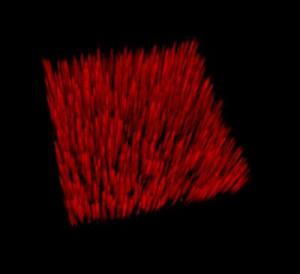Sep 3 2014
Vertical nanowires could be used for detailed studies of what happens on the surface of cells. The findings are important for pharmaceuticals research, among other applications. A group of researchers from Lund University in Sweden have managed to make artificial cell membranes form across a large number of vertical nanowires, known as a 'nano-forest'.
 This image shows a 3-dimensional confocal fluorescence microscopy images of lipid membranes (red dye) supported by a nanowire forest. Credit: Aleksandra Dabkowska
This image shows a 3-dimensional confocal fluorescence microscopy images of lipid membranes (red dye) supported by a nanowire forest. Credit: Aleksandra Dabkowska
All communication between the interior of a cell and its surroundings takes place through the cell membrane. The membrane is a surface layer that holds the cell together and that largely comprises lipids, built of fatty acids. Inside the cell there are also various types of membrane, all with their own specific role.
Studies of cell membranes using nanotechnology have up to now mainly involved studying artificial membranes on flat surfaces, but because many membranes in the body have a curved shape, a different type of nano-surface is needed. In a new scientific study, researchers from Lund University have used vertical nanowires to create more varied surfaces on which artificial membranes can form. The Lund researchers have built an entire forest of upright nanowires on a one millimetre squared surface, on which they have succeeded in forming artificial membranes that are curved in the same way as many natural cell membranes.
"Our research demonstrates that artificial membranes can follow the curved surface formed by the nanowires, which creates unique opportunities to study membranes in a curved state", said Aleksandra Dabkowska from the Department of Chemistry at Lund University.
The nanowires also act as fine feelers that can measure how the membrane works. For instance, the vertical nanowires can be used to study different proteins that are active in the body's cell membranes. Because of their barrier function on the surface of the cell, these proteins are the target of a range of different drugs. The nano-forest could therefore be of great importance for pharmaceutical research, as well as for basic cell research, partly because the nano-surfaces are very precisely controlled as regards the length, thickness and spacing of the nanowires, and partly because the nano-forest multiplies the total study surface compared with a flat nano-landscape.